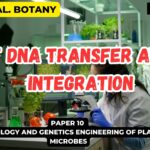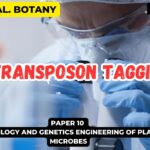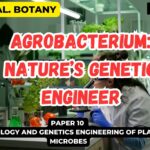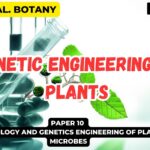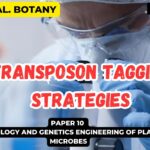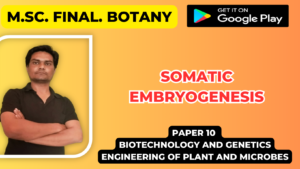Chloroplast Transformation
- Chloroplast is a specialized organelles present in photosynthetic plant cells (Algae to higher plants).
- Their principal function is to capture energy from light for the fixation of atmospheric CO2 and convert it into sugars. In addition it also harbour many other important biosynthetic pathways.
- They possess their own genome with a variable size up to several hundred kilobases; each chloroplast can contain up to 100 copies of its own genome.
- The number of chloroplast varies between 1 and more than 100 in higher plants.
- Chloroplast transformation offers an important tool to investigate in term of many aspects of plant physiology and the regulation of gene expression.
- It has also got much attention for applications in biotechnology due to several advantages as compared with transformation of the nuclear genome.
- It is also important that in the most of flowering plants including crops, the chloroplast genome is inherited to progeny through the maternal parent, while transmission of chloroplast through pollen is very rare.
- Thus, plastid transformation provides a strong level of biological containment.
- Another advantage is that the integration of a transgene in the plastid genome proceeds by homologous recombination and is therefore precise and predictable.
- Hence, variable position effects on gene expression or the inadvertent inactivation of a host gene by integration of the transgene are avoided.
- Furthermore, plastid genes are not subject to gene silencing or RNA interference. Recent reviews have focused on the numerous applications of plastid transformation for the production of pharmaceuticals or biofuels, and on the development of transformation protocols in a rapidly increasing number of plant and algal species.
- Plastid transformation can involve delivery of DNA into chloroplasts or non-green plastids. Once stable transformation has been achieved, all plastid types within the plant will contain the same transgenic plastome.
- Thus, in flowering plants containing a variety of plastid developmental forms, the term plastid transformation is more accurate than chloroplast transformation.
- First time chloroplast transformation was achieved in the alga Chlamydomonas reinhardtii. In addition, the aadA marker and methods for removal of marker were first demonstrated. In higher plants, Tobacco gained significant attention for chloroplast transformation due to its easy to culture and regeneration.
- Tobacco protoplasts were co-cultivated with Agrobacterium but the resulted transgenic lines showed the unstable integration of foreign DNA into the chloroplast genome.
- The interested genes were introduced in isolated intact chloroplasts and then into protoplasts resulting in transgenic plants.
- Gene gun, a transformation device, was developed by John Sanford to enable the transformation of plant chloroplasts without using isolated plastids.
Transformation methods for chloroplast transformation
- First successful chloroplast transformation was performed in Chlamydomonas reinhardtii by particle Biolistic/Particle bombardment method.
- Subsequently the stable plastid transformation has also been established in higher plants, Nicotiana tobacum, Arabidopsis, rape, Lesquerella, rice, potato, lettuce, soybean, cotton, carrot and tomato.
- However, plastid transformation is routinely performed only in tobacco because of higher efficiency of transformation in tobacco than in other plants.
- Simple operation and high transformation efficiency makes it a favorable way for plastid or chloroplast transformation.
- PEG-mediated and Agrobacterium- mediated transformation method was also employed in the early days.
- In this method a protoplasts (plant cell without cell wall) treated with of PEG which allows permeabilization of the plasma membrane and facilitates uptake of DNA. Subsequently, with a mechanism largely uncharacterized, the plasmid DNA passes the plastid membranes and reaches the stroma where it integrates into the plastome as during biolistic transformation.
- The plastid transformation can also be done by using vector. Initial transformation vectors carried a plastid 16S rRNA (rrn16) gene with point mutations that confer spectinomycin and streptomycin resistance.
- The recessive rrn16 marker genes were, 100-fold less efficient than the currently used aadA gene.
- The aadA gene encodes aminoglycoside 30-adenylyltransferase, an enzyme that inactivates spectinomycin and streptomycin by adenylation.
Vector design for chloroplast transformation
Selectable marker genes
- Due to the presence of multi-copy plastid DNA, selectable marker genes are very important to achieve uniform transformation of all genome copies.
- The nontransformed plastids are gradually left out during an enrichment process using a selective medium. Initially plastid 16S rRNA gene (rrn16) was used as a selection marker in process of chloroplast transformation.
- The transgenic lines were selected by spectinomycin resistance but efficiency was very low.
- A range of selectable markers for chloroplast transformation have been developed based on various features like dominance, cell-autonomy or portability.
- Dominant markers confer high transformation efficiency due to the expression at early stages although present in a minority of the plastomes. e. g. aadA (aminoglycoside 3′ adenylyltransferase) gene confers resistance to streptomycin and spectinomycin by inactivation of antibiotics.
- Recessive markers confer lower transformation efficiency.
- They confer resistance only when enough transformed plastome copies are produced by random segregation resulting in a selectable phenotype. e. g. point mutation in the ribosomal RNA, rrnS and rrnL genes, confer antibiotic resistance by relieving the sensitivity of individual ribosome.
- Plastid- or cell-autonomous markers confer their phenotype only to the organelle or the cell in which they reside. Some markers may integrate at a specific locus of the plastid genome e.g. rrnS or rrnL genes.
- Autonomous and portable markers can be inserted virtually in any locus of the plastome e.g. aadA gene. Some markers have a property to confer a phenotype strong enough for direct selection of transformants.

Insertion sites
- Plastid expression vectors possess left and right flanking sequences each with 1–2 kb in size from the host plastid genome, which facilitates foreign gene insertion into plastid DNA via homologous recombination.
- The insertion site in the plastid genome is determined by the choice of plastid DNA segment flanking the marker gene and the gene of interest.
- The foreign DNA is inserted in intergenic regions of the plastid genome.
- Various insertion sites such as trnV-3’rps12,trnI-trnA and trnfM-trnG are frequently used in this in this technique.
- The trnV-3’rps12 and trnI-trnA sites are located in the 25 kb inverted repeat region of plastid DNA and insertion of gene into these sites results in the rapid copying into two copies in the inverted repet region.
- The insertion site trnfM-trnG is located in the large single copy region of the plastid DNA. The insertion of gene between trnfM and trnG should contain only one copy per plastid DNA. pSBL- CTV2 was the first vector developed in the
- Daniell laboratory for expression of several proteins. This vector inserts the foreign gene in trnI-trnA intergenic region.
Regulatory sequences
- The level of gene expression in plastids is predominately regulated by regulatory sequences such as promoter as well as 5′ UTR elements.
- Strong promoter is required for high mRNA level, for high-level of protein accumulation e.g. rRNA operon (rrn) promoter (Prrn).
- Most commonly used promoter is CaMV 35S from cauliflower mosaic virus which drives high level of transgene expression in dicots.
- In plastid expression vectors, a suitable 5′ untranslated region (5′-UTRs) containing a ribosomal binding site (RBS) is an important element.
- Stability of the transgenic mRNA is ensured by the 5′ UTR and 3′ UTR sequences flanking the transgene.
- Protein accumulation from the transgene depends on the 5′UTR inserted upstream of the open reading frame encoding the genes of interest.
Advantages of chloroplast transformation
- Chloroplast transformation offer several advantages in compare to nuclear transformation which are as follows-
Risk of transgene escape:
- Chloroplast genome is maternally inherited and there is rare occurrence of pollen transmission. It provides a strong level of biological containment and thus reduces the escape of transgene from one cell to other.
Expression level:
- It exhibits higher level expression of transgene and thus higher level of protein production due to the presence of multiple copies of chloroplast transgenes per cell and in addition it remains unaffected by phenomenon such as pre or post-transcriptional silencing.
Homologous recombination:
- Chloroplast transformation involves homologous recombination and is therefore precise and predictable.
- It minimizes the insertion of unwanted DNA that accompanies in nuclear genome transformation.
- This also avoids the deletions and rearrangements of transgene DNA, and host genome DNA at the site of insertion.
Gene silencing/ RNA interference:
- Gene silencing or RNA interference does not occur in genetically engineered chloroplasts.
Position effect:
- Absence of position effect due to lack of a compact chromatin structure and efficient transgene integration by homologous recombination.
- Avoids inadvertent inactivation of host gene by transgene integration
Disulphide bond formation:
- Ability to form disulfide bonds and folding human proteins results in high-level production of biopharmaceuticals in plants.
Multiple gene expression:
- Multiple transgene expression is possible due to polycistronic mRNA transcription.

Expression of edible vaccine:
- High level of expression and engineering foreign genes without the use of antibiotic resistant genes makes this compartment ideal for the development of edible vaccines.
Codon usage:
- Chloroplast is originated from cyanobacteria through endosymbiosis. It shows significant similarities with the bacterial genome.
- Thus, any bacterial genome can be inserted in chloroplast genome.
Expression of toxic proteins:
- Foreign proteins observed to be toxic in the cytosol are non-toxic when accumulated within transgenic chloroplasts as they are compartmentalized inside chloroplast.
Limitations of Chloroplast Transformation
- Transformation frequencies are much lower than those for nuclear genes.
- Prolonged selection procedures under high selection pressure are required for the recovery of transformants.
- The methods of transgene transfer into chloroplasts are limited, and they are either expensive or require regeneration from protoplasts.
- These transformation systems are far more successful with tobacco than with other plant species.
- Products of transgenes ordinarily accumulate in green parts only.
Risk and Controversies
- The introduction of transgenic crops and foods into the existing food production system has generated a number of questions about possible negative consequences.
- The dispute involves consumers, farmers, biotechnology companies, governmental regulators, non-governmental organizations, and scientists.
- The key areas of controversy related to genetically modified food (GMO food), whether such food should be labeled, the role of government regulators, the objectivity of scientific research and publication, the effect of genetically modified crops on health and the environment, the effect on pesticide resistance, the impact of such crops for farmers, and the role of the crops in feeding the world population.
- People with concerns about this technology have reacted in many ways, from participating in letter-writing campaigns to demonstrating in the streets to vandalizing institutions where transgenic research is being conducted.
- What are the main concerns?
- What scientific support is there for these concerns?
- The issues surrounding objections to transgenic crops can be broadly grouped into concerns about
- Damage to human health Allergenicity, horizontal transfer and antibiotic resistance, eating foreign DNA, cauliflower mosaic virus promoter, changed nutrient levels
- Damage to the natural environment Monarch butterfly, crop-to-weed gene flow, antibiotic resistance, leakage of GM proteins into soil, reductions in pesticide spraying: are they real?
- Disruption of current practices of farming and food production in developed countries crop-to-crop gene flow
- Disruption of traditional practices and economies in less developed countries
Concerns about human health
Allergenicity
- The possibility that we might see an increase in the number of allergic reactions to food as a result of genetic engineering has a powerful emotional appeal because many of us experienced this problem before the advent of transgenic crops, or know of someone who did.
- However, there is no evidence so far that genetically engineered foods are more likely to cause allergic reactions than are conventional foods.
- Tests of several dozen transgenic foods for allergenicity have uncovered only a soybean that was never marketed and the now-famous StarLink corn.
- Although the preliminary finding is that StarLink corn is probably not allergenic, the scientific debate continues.
- Every year some people discover that they have developed an allergy to a common food such as wheat or eggs, and some people may develop allergies to transgenic foods in the future, but there is no evidence that transgenic foods pose more of a risk than conventional foods do.
Horizontal transfer and antibiotic resistance
- The use of antibiotic resistance markers in the development of transgenic crops has raised concerns about whether transgenic foods will play a part in our loss of ability to treat illnesses with antibiotic drugs.
- At several stages of the laboratory process, developers of transgenic crops use DNA that codes for resistance to certain antibiotics, and this DNA becomes a permanent feature of the final product although it serves no purpose beyond the laboratory stage. Will transgenic foods contribute to the existing problems with antibiotic resistance?
- One concern is that the enzyme product of the DNA might be produced at low levels in transgenic plant cells.
- While high processing temperatures would inactivate the enzyme in processed foods, ingestion of fresh or raw transgenic foods could result in the stomach containing a small amount of an enzyme that inactivates an orally administered dose of the antibiotic.
- This issue was raised during the approval processes for Calgene’s FlavrSavr tomato and Ciba-Geigy’s Bt corn 176. In both cases, tests showed that orally administered antibiotics would remain effective.
- While the risks from antibiotic resistance genes in transgenic plants appear to be low, steps are being taken to reduce the risk and to phase out their use.
Eating foreign DNA
- When scientists make a transgenic plant, they insert pieces of DNA that did not originally occur in that plant. Often these pieces of DNA come from entirely different species, such as viruses and bacteria. Is there any danger from eating this “foreign” DNA?
- We eat DNA every time we eat a meal. DNA is the blueprint for life and all living things contain DNA in many of their cells. What happens to this DNA?
- Most of it is broken down into more basic molecules when we digest a meal.
- A small amount is not broken down and is either absorbed into the blood stream or excreted in the feces.
- So far there is no evidence that DNA from transgenic crops is more dangerous to us than DNA from the conventional crops, animals, and their attendant micro-organisms that we have been eating all our lives.
Changed nutrient levels
- How do genetically engineered foods compare with conventional foods in nutritional quality? This is an important issue, and one for which there will probably be much research in the future, as crops that are engineered specifically for improved nutritional quality are marketed.
- However, there have been only a few studies to date comparing the nutritional quality of genetically modified foods to their unmodified counterparts.
- The central question for GE crops that are currently available is whether plant breeders have accidentally changed the nutritional components that we associate with conventional cultivars of a crop.
- Because isoflavones are thought to play a role in preventing heart disease, breast cancer, and osteoporosis, the isoflavone content of Roundup Ready soybeans has been investigated by several researchers.
- The studies completed so far do not resolve the issue of whether RoundupReady soybeans have isoflavone levels comparable to conventional varieties, but the differences found in experiments appear to be small or moderate in comparison with natural variation in isoflavone levels.
- Additional evidence may clarify the arguments for and against Roundup applications as a risk factor in soybean cultivation.
- Industry studies submitted in support of applications for permission to sell transgenic crops indicate that the nutritional components that are commonly tested are similar in transgenic foods and conventional foods.
Concerns about damage
- to the environment Biodiversity Crop genetic diversity might decrease due to the development of superior GM strains that crowd others out of the market.
- Indirect effects might affect other organisms.
- To the extent that agrochemicals impact biodiversity, modifications that increase their use, either because successful strains require them or because the accompanying development of resistance will require increased amounts of chemicals to offset increased resistance in target organisms.
- Studies comparing the genetic diversity of cotton found that in the US diversity has either increased or stayed the same, while in India it has declined.
- This difference was attributed to the larger number of modified varieties in the US compared to India.
- A review of the effects of Bt crops on soil ecosystems found that in general they “appear to have no consistent, significant, and long-term effects on the microbiota and their activities in soil”.
- The diversity and number of weed populations has been shown to decrease in farm-scale trials in the United Kingdom and in Denmark when comparing herbicide-resistant crops to their conventional counterparts.
- The UK trial suggested that the diversity of birds could be adversely affected by the decrease in weed seeds available for foraging.
- A 2005 study designed to “simulate the impact of a direct overspray on a wetland” with four different agrochemicals (carbaryl (Sevin), malathion, 2,4dichlorophenoxyacetic acid, and glyphosate in a Roundup formulation) by creating artificial ecosystems in tanks and then applying “each chemical at the manufacturer’s maximum recommended application rates” found that “species richness was reduced by 15% with Sevin, 30% with malathion, and 22% with Roundup, whereas 2,4-D had no effect”.
- The study has been used by environmental groups to argue that use of agrochemicals causes unintended harm to the environment and to biodiversity.
Secondary pests
- Several studies documented surges in secondary pests within a few years of adoption of Bt cotton.
- In China, the main problem has been with mirids, which have in some cases “completely eroded all benefits from Bt cotton cultivation”.
- A 2009 study in China concluded that the increase in secondary pests depended on local temperature and rainfall conditions and occurred in half the villages studied.
- The increase in insecticide use for the control of these secondary insects was far smaller than the reduction in total insecticide use due to Bt cotton adoption.
- The finding was consistent with a hypothesis that more pesticide sprayings are needed over time to control emerging secondary pests, such as aphids, spider mites, and lygus bugs.
- Similar problems have been reported in India, with mealy bugs and aphids.
Crop-to-weed gene flow
- Hybridization of crops with nearby weeds may enable weeds to acquire traits we wish they didn’t have, such as resistance to herbicides.
- Research results indicate that crop traits may escape from cultivation and persist for many years in wild populations.
- Genes that provide a competitive edge, such as resistance to viral disease, could benefit weed populations around a crop field. Many cultivated crops have sexually compatible wild relatives with which they hybridize under favorable circumstances.
- The likelihood that transgenes will spread can be different for each crop in each area of the world.
- For example, there are no wild relatives of corn in the United States or in Europe for transgenic corn to pollinate, but such wild relatives exist in Mexico.
- Soybeans and wheat are self-pollinating crops, so the risk of transgenic pollen moving to nearby weeds is small.
- However, that small risk must balanced against the fact that there are wild relatives of wheat in the United States.
- There are no wild relatives of soybean in the United States, but such wild relatives exist in China.
- Thus each crop must be evaluated individually for the risk of gene flow in the area where it will be grown.
Antibiotic resistance
- There is also concern that transgenic plants growing in the field will transfer their antibiotic resistance genes to soil micro-organisms, thus causing a general increase in the level of antibiotic resistance in the environment.
- However, many soil organisms have naturally occurring resistance as a defense against other organisms that generate antibiotics, so genes contributed occasionally by transgenic plants are unlikely to cause a change in the existing level of antibiotic resistance in the environment.
Leakage of GM proteins into soil
- Many plants leak chemical compounds into the soil through their roots.
- There are concerns that transgenic plants may leak different compounds than conventional plants do, as an unintended consequence of their changed DNA. Speculation that this may be happening leads to concern about whether the communities of micro-organisms living near transgenic plants may be affected.
- The interaction between plants and soil micro-organisms is very complex, with the micro-organisms that live around plant roots also leaking chemical compounds into the soil.
- Much more research must be done before we understand the relationships that occur between micro-organisms and conventional crops.
- Attempts to discover whether transgenic plants are changing the soil environment, and whether they are changing it in good ways or bad ways, are hindered by our lack of basic scientific knowledge.
Reductions in pesticide spraying
- One of the most appealing arguments in favor of transgenic plants is the potential for reducing the damage we do to our environment with conventional methods of farming.
- Pest-resistant crops such as Bt corn and Bt cotton have been promoted as a means to reduce the spraying of pesticides, while herbicide-tolerant crops such as Roundup Ready soybeans are said to reduce the application of herbicides.
- Large reductions in chemical spraying have been claimed to result from the introduction of these transgenic varieties.
- Are the claims true? Bt cotton is the only crop for which claims of reduced spraying are clear. Analysts paint a mixed picture on the results of planting Roundup Ready soybeans.
- Bt corn and herbicide-tolerant cotton and corn have not resulted in clear reductions in the spraying of chemicals.
Concerns about damage to current farming practices
Crop-to-crop gene flow
- Hybridization of transgenic crops with nearby conventional crops raises concerns about separation distances to ensure purity of crops and about who must pay if unwanted genes move into a neighbor’s crop.
- As “Identity Preservation” and segregation of GM from non-GM crops become factors in marketing products, it will be important to ensure that hybridization is not occurring in the field.
- Many factors influence the potential for gene flow from crop to crop. Some crops are highly outcrossing, with pollen carried to other fields by wind and by insects.
Other species are highly self-pollinating, with little potential for pollen transfer to neighboring plants. - Because of the differences among crops species, every case must be evaluated individually for potential to contribute to gene flow from transgenic to conventional crops. If GM pollen pollinates plants in a neighboring field, then the issue of genetic trespass may arise.
- What level of GM presence, if any, should be allowed in products that are sold as organic or conventional? Should GM farmers and companies bear responsibility for preventing gene flow, or should conventional and organic farmers pay to protect their products from gene flow?
- Should GM versions of outcrossing plants be banned as too risky, while GM versions of selfpollinating plants are permitted?
- These issues have already prompted several lawsuits and they will continue to be a factor in the development and use of trangenic plants for years to come.
Controversial studies
Pusztai affair
- Arpad Pusztai published the first peer-reviewed paper to find negative effects from GM food consumption in 1999.
- Pusztai fed rats potatoes transformed with the Galanthus nivalis agglutinin (GNA) gene from the Galanthus (snowdrop) plant, allowing the tuber to synthesise the GNA lectin protein.
- While some companies were considering growing GM crops expressing lectin, GNA was an unlikely candidate.
- Lectin is toxic, especially to gut epithelia Pusztai reported significant differences in the thickness of the gut epithelium, but no differences in growth or immune system function. On June 22, 1998, an interview on Granada Television’s current affairs programme World in Action,
- Pusztai said that rats fed on the potatoes had stunted growth and a repressed immune system.
- A media frenzy resulted. Pusztai was suspended from the Rowett Institute. Misconduct procedures were used to seize his data and ban him from speaking publicly.
Bt corn
- A 2011 study was the first to evaluate the correlation between maternal and fetal exposure to Bt toxin produced in GM maize and to determine exposure levels of the pesticides and their metabolites.
- It reported the presence of pesticides associated with the modified foods in women and in pregnant women’s foetuses.
- The paper and related media reports were criticized for overstating the results. Food Standards Australia New Zealand (FSANZ) posted a direct response, saying that the suitability of the ELISA method for detecting the Cry1Ab protein was not validated and that no evidence showed that GM food was the protein’s source.
- The organization also suggested that even had the protein been detected its source was more likely conventional or organic food.
Indian controversies
- India is an agrarian country with around 60% of its people depending directly or indirectly upon agriculture. From 1995 to 2013, a total of 296,438 farmers have killed themselves in India, or an average of 16,469 suicides per year.
- During the same period, about 9.5 million people died per year in India from other causes including malnutrition, diseases and suicides that were non-farming related, or about 171 million deaths from 1995 to 2013.
- Activists and scholars have offered a number of conflicting reasons for farmer suicides, such as monsoon failure, high deBt burdens, genetically modified crops, government policies, public mental health, personal issues and family problems.
- There is also accusation of states fudging the data on farmer suicides. In India, GM cotton yields in Maharashtra, Karnataka, and Tamil Nadu resulted in an average 42% increase in yield in 2002, the first year of commercial planting.
- A severe drought in Andhra Pradesh that year prevented any increase in yield, because the GM strain was not drought tolerant. Drought-tolerant variants were later developed. Driven by substantially reduced losses to insect predation, by 2011 88% of Indian cotton was modified.
- Though disputed, the economic and environmental benefits of GM cotton to farmers have been documented.
- A study from 2002 through 2008 on the economic impacts of Bt cotton in India, showed that Bt cotton increased yields, profits and living standards of smallholder farmers. However, recently cotton bollworm has been developing resistance to Bt cotton.
- Consequently, in 2012 Maharashtra banned Bt cotton and ordered an independent socioeconomic study of its use. Indian regulators cleared the Bt brinjal, a genetically modified eggplant, for commercialisation in October 2009.
- After opposition by some scientists, farmers and environmental groups, a moratorium was imposed on its release in February 2010 “for as long as it is needed to establish public trust and confidence”. As of 1 January 2013, all foods containing GMOs must be labelled.
- The Legal Metrology (Packaged Commodities) Rules, 2011 states that “every package containing the genetically modified food shall bear at the top of its principal display panel the letters ‘GM’” The rules apply to 19 products including biscuits, breads, cereals and pulses, and a few others.
- The law faced criticism from consumer rights activists as well as from the packaged-food industry; both sides had major concerns that no logistical framework or regulations had been established to guide the law’s implementation and enforcement.
- On March 21, 2014, the Indian government revalidated 10 GM-based food crops and allowed field trials of GM food crops, including wheat, rice and maize.

